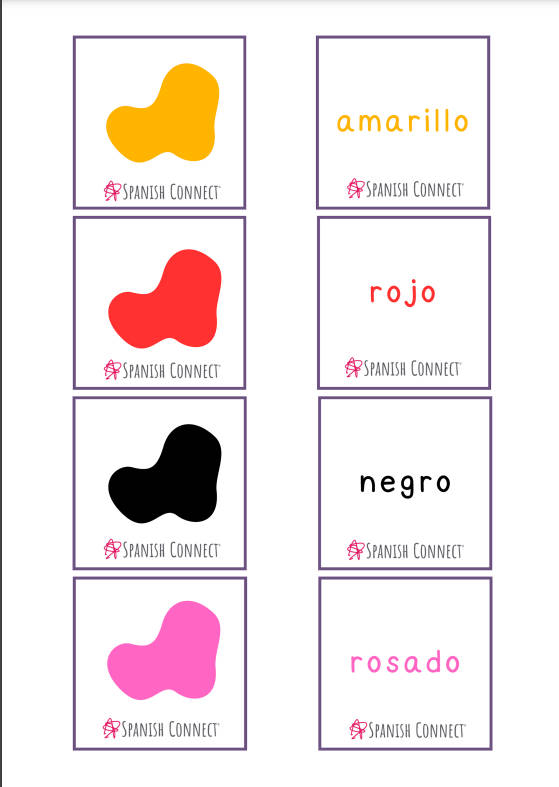Hola, fellow parents! As a mum and Spanish teacher, I’m thrilled to share with you some of my tried-and-true tips for teaching colors in Spanish to your little ones.
Kids are like sponges, and introducing them to colors early in their Spanish learning journey can make a world of difference.
So, let’s dive in and explore how you can make learning the colors in Spanish a fun and enjoyable experience for your child!
Table of Contents
Importance of Teaching Colors in Spanish to Kids
Teaching colors in Spanish not only helps build your child’s vocabulary, but it also lays the foundation for future language learning.
Colors are an essential part of daily conversations, and when kids learn them in context, they’re more likely to remember and use them correctly.
Plus, knowing the colors in Spanish helps children develop their descriptive skills and express themselves more clearly.
How to Teach Your Kids the Colors in Spanish
One of the best ways to teach colors in Spanish is by incorporating them into everyday conversations.
This can be as simple as pointing out objects around the house, asking your child to pick out a specific color from their toy box, or describing the colors of the clothes they’re wearing.
For best results, teach the colors in context and use them consistently throughout your daily interactions. Here are some suggestions for incorporating color vocabulary into your child’s daily interactions, making learning colors in Spanish a fun and natural part of their everyday life:
- When getting dressed, ask your child to find clothes in specific colors.
- During mealtime, talk about the colors of different foods.
- On a walk or drive, point out colorful objects or buildings.
- Encourage your child to draw or paint pictures using different colors and describe them in Spanish.
Colors in Spanish list
To help you get started, here’s a handy list of the most common colors in Spanish, along with their English translations and pronunciation guides:
- Rojo (red) – roh-hoh
- Amarillo (yellow) – ah-mah-ree-yoh
- Azul (blue) – ah-sool
- Verde (green) – vehr-deh
- Naranja (orange) – nah-rahn-hah
- Rosado (pink) – roh-sah-doh
- Morado (purple) – moh-rah-doh
- Marrón (brown) – mah-rohn
- Gris (grey) – grees
- Blanco (white) – blahng-koh
- Negro (black) – neh-groh
Additionally, here are some more advanced colors:
- Celeste (sky blue) – seh-lehs-teh
- Turquesa (turquoise) – toor-keh-sah
- Lavanda (lavender) – lah-vahn-dah
- Beige (beige) – bayh-heh
- Dorado (golden) – doh-rah-doh
- Plateado (silver) – plah-teh-ah-doh
Now, let’s explore some easy-to-understand examples of phrases and questions that feature colors in Spanish, perfect for helping your child practice their newfound knowledge.
Examples of Simple Phrases and Questions Related to all Colors in Spanish
Here are some simple examples of phrases and questions related to colors in Spanish, perfect for helping your child practice their new language skills in a fun and easy way:
- ¿Cuál es tu color favorito? (What is your favourite color?)
- La manzana es roja. (The apple is red.)
- La camisa es azul. (The shirt is blue.)
- ¿De qué color es el cielo? (What color is the sky?)
- Los zapatos son negros. (The shoes are black.)
- La flor es amarilla. (The flower is yellow.)
- ¿De qué color es la pelota? (What color is the ball?)
Teaching Colors through Songs and Rhymes
Songs and rhymes are a fantastic way to teach colors in Spanish to your kids, as they make learning fun and memorable.
When singing and dancing along with your child, encourage them to point out the colors they see or hear in the songs. This will help reinforce their learning and make the experience even more enjoyable.
Once your child has a solid grasp of the basic colors, you can introduce more advanced songs, which are 100% in Spanish and present the colors in context.
Here are some great options:
Teaching Colors through Color-Based Games and Activities
You can also boost your child’s learning experience with engaging color-based games and activities that make practicing colors in Spanish both fun and interactive, here are some ideas:
- Color scavenger hunt: Create a list of colors in Spanish and have your child find objects around the house or outside that match each color.
- Color sorting: Provide your child with a collection of small objects in different colors (e.g., buttons, beads, or toys) and ask them to sort them by color while saying the color names in Spanish.
- Coloring pages: Find or create coloring pages with images and color names in Spanish, and have your child color them in while repeating the color names aloud.
- “I Spy” in Spanish: Play the classic “I Spy” game, but use Spanish color names to describe the objects you see.
- Flashcard Color Matching Game: Download and print the following set of flashcards with color images and their corresponding Spanish color names. Lay out the color image flashcards on the table, and have your child match the color name flashcards to the correct color image. As they match each pair, encourage them to say the color name in Spanish aloud. This activity reinforces color recognition and helps children practice their Spanish color vocabulary.

How to Use Spanish Colors in Sentences
Using colors in sentences might seem tricky at first, but with a few simple tips, you’ll be able to help your child master this skill.
Here’s a quick guide to help you understand how to use Spanish colors in sentences, along with examples for each point:
Colors as adjectives
In Spanish, unlike English, when a color is used as an adjective, the color usually comes after the thing it describes.
- El auto rojo (The red car)
- La casa blanca (The white house)
- La mochila negra (The black backpack)
In Spanish, colors need to match the noun they’re describing in both gender (masculine or feminine) and number (singular or plural).
This means that when a color is used as an adjective, its form should change to agree with the noun it’s describing.
Here’s a more detailed explanation, along with examples:
Gender agreement
- If the noun is masculine, the color should also be in its masculine form. Example: El gato negro (The black cat) – “gato” is masculine, so “negro” is also masculine.
- If the noun is feminine, the color should be in its feminine form. Example: La camisa roja (The red shirt) – “camisa” is feminine, so “roja” is also feminine.
Number agreement
- If the noun is singular, the color should also be singular. Example: El coche amarillo (The yellow car) – “coche” is singular, so “amarillo” is also singular.
- If the noun is plural, the color should be plural. Example: Los zapatos marrones (The brown shoes) – “zapatos” is plural, so “marrones” is also plural.
- When a color name is used in plural form, it usually adds an “-s” if it ends in a vowel (like “verde” becoming “verdes”) or “-es” if it ends in a consonant(like “azul” becoming “azules”).
Additional descriptive words for adjectives of color
When using adjectives of color, you can also add additional descriptive words to create a more specific color. For example:
- Un vestido verde oscuro (A dark green dress) – “verde oscuro” means “dark green.”
- Una bufanda azul claro (A light blue scarf) – “azul claro” means “light blue.”
- Un sombrero gris oscuro (A dark grey hat) – “gris oscuro” means “dark grey.”
By adding these descriptive words to the color, you can create a more precise and specific shade, making your speech more nuanced and colorful!
Describing nouns ( using “de color”)
In Spanish, when you want to describe a noun using a color, you can use the phrase “de color” to indicate the color of the noun. Here are a few examples:
- Un perro de color marrón (A brown dog) – “de color” means “of color,” so this phrase means “a dog of (the) brown (color).”
- Una caja de color naranja (An orange box) – “de color” again means “of color,” so this phrase means “a box of (the) orange (color).”
- Un lápiz de color rosa (A pink pencil) – once again, “de color” means “of color,” so this phrase means “a pencil of (the) pink (color).”
This construction can be especially useful when you want to be very specific about the color of something, or when you want to describe a unique shade that doesn’t have a single word equivalent in Spanish.
By using “de color,” you can make your speech more descriptive and interesting!
Colors as nouns
Colors can also be used as nouns to represent a particular color in general. When used in this way, they are always masculine. Here are some examples:
- El azul es mi color favorito (Blue is my favourite color) – “el azul” means “the blue (color),” and “el” is the masculine singular article used before a masculine singular noun.
- El verde representa la naturaleza (Green represents nature) – “el verde” means “the green (color),” and “el” is again the masculine singular article.
- El rojo simboliza el amor (Red symbolizes love) – “el rojo” means “the red (color),” and “el” is still the masculine singular article.
By using colors as nouns, you can make your speech more expressive and poetic, and you can use them to convey emotions or symbolism associated with particular colors.
How to Use Colors to Describe People’s Apperance in Spanish
Describing people’s appearance is a great way to practice using colors in Spanish. Here’s a helpful list of examples to get your child started with using colors to describe hair, eyes, and skin tones:
Hair colors in Spanish (Colores de cabello)
- Ella tiene cabello rubio. (She has blonde hair.)
- Él tiene cabello castaño. (He has brown hair.)
- Su cabello es negro. (His/her hair is black.)
- Tiene cabello pelirrojo. (He/she has red hair.)
- Su cabello es gris. (His/her hair is grey.)
Eye colors in Spanish (Colores de ojos)
- Sus ojos son verdes. (Her eyes are green.)
- Tiene ojos azules. (He/she has blue eyes.)
- Sus ojos son marrones. (His/her eyes are brown.)
- Tiene ojos grises. (He/she has grey eyes.)
- Sus ojos son de color miel. (His/her eyes are hazel.)
Skin colors (Colores de piel)
- Su piel es morena. (Her/his skin is tanned.)
- Tiene piel clara. (He/she has fair skin.)
- Su piel es oscura. (His/her skin is dark.)
- Tiene piel oliva. (He/she has olive skin.)
- Su piel es pálida. (His/her skin is pale.)
Your child can use these phrases when describing people they know or characters from their favourite stories. This will help them become more comfortable using colors in Spanish and expand their vocabulary.
Wrap Up
Teaching colors in Spanish to kids is an enjoyable and rewarding experience.
By incorporating colors into everyday conversations, using songs and rhymes, engaging in fun activities, and practising in context, you’ll set the foundation for your child’s Spanish language learning journey.
Ready to take the next step in your child’s Spanish language learning journey? Check out our article on Numbers in Spanish, where we provide fun and easy ways to teach your child the basics of counting in Spanish.





